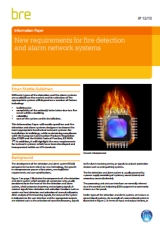New requirements for fire detection and alarm network systems IP 12 13
BRE (Building Research Establishment) is an independent, research-based consultancy, testing and training organisation, operating in the built environment and associated industries.
New requirements for fire detection and alarm network systems (IP 12/13) was written by Eman Mattie-Suleiman and published by BRE on 30 September 2013.
A fire detection and alarm systems (FDAS) typically consists of a processer unit, which receives signals from detection and activation functions such as smoke and heat detectors and activation of manual call points. After analysis of the incoming signals, the status of the system is indicated via the user interface and the appropriate outputs are initiated such as the activation of sounders/beacons, signals to the alarm receiving centre, or signals to activate protection devices such as extinguishing systems.
The development of FDAS components has been driven by new technology, the growth in microprocessor power at low prices, new legislative requirements and user specifications. Different types of FDAS are now available on the market and the selection of the appropriate system will depend on a number of factors including:
- Building size.
- Complexity of the action(s) to be taken due to a fire event within a building.
- Reliability.
- Cost of the system and its installation.
This 12 page BRE information paper enables the specifiers and designers of fire detection and alarm systems to choose the most appropriate hard-wired network systems whilst maintaining compliance with the Construction Products Regulation (CPR) and BS 5839-1 (Fire detection and fire alarm systems for buildings. Code of practice for design, installation, commissioning and maintenance of systems in non-domestic premises). It also highlights the requirements for network systems which have been developed and incorporated within a Loss Prevention Standards (LPS) standard.
The contents of the information paper are:
- Background-Introduction of network systems.
- Reasons for networking fire detection and alarm systems.
- Current requirements for fire detection network systems.
- New fire detection and alarm system network requirements.
- References.
[edit] Related articles on Designing Buildings Wiki
- Automatic fire detection and alarm systems, an introductory guide to components and systems BR 510.
- BRE articles on Designing Buildings Wiki.
- BRE Buzz articles on Designing Buildings Wiki.
- BRE Buzz.
- Building Research Establishment.
- Fire detection and alarm system.
- Fire detector.
- Fire.
- Heat alarm.
- Ionisation smoke alarm.
- Multi-sensor alarm.
- Optical smoke alarm.
- Over £1 billion lost every year due to false alarms.
- The causes of false fire alarms in buildings.
Featured articles and news
Professional practical experience for Architects in training
The long process to transform the nature of education and professional practical experience in the Architecture profession following recent reports.
A people-first approach to retrofit
Moving away from the destructive paradigm of fabric-first.
International Electrician Day, 10 June 2025
Celebrating the role of electrical engineers from André-Marie Amperè, today and for the future.
New guide for clients launched at Houses of Parliament
'There has never been a more important time for clients to step up and ...ask the right questions'
The impact of recycled slate tiles
Innovation across the decades.
EPC changes for existing buildings
Changes and their context as the new RdSAP methodology comes into use from 15 June.
Skills England publishes Sector skills needs assessments
Priority areas relating to the built environment highlighted and described in brief.
BSRIA HVAC Market Watch - May 2025 Edition
Heat Pump Market Outlook: Policy, Performance & Refrigerant Trends for 2025–2028.
Committing to EDI in construction with CIOB
Built Environment professional bodies deepen commitment to EDI with two new signatories: CIAT and CICES.
Government Grenfell progress report at a glance
Line by line recomendation overview, with links to more details.
An engaging and lively review of his professional life.
Sustainable heating for listed buildings
A problem that needs to be approached intelligently.
50th Golden anniversary ECA Edmundson apprentice award
Deadline for entries has been extended to Friday 27 June, so don't miss out!
CIAT at the London Festival of Architecture
Designing for Everyone: Breaking Barriers in Inclusive Architecture.
Mixed reactions to apprenticeship and skills reform 2025
A 'welcome shift' for some and a 'backwards step' for others.























